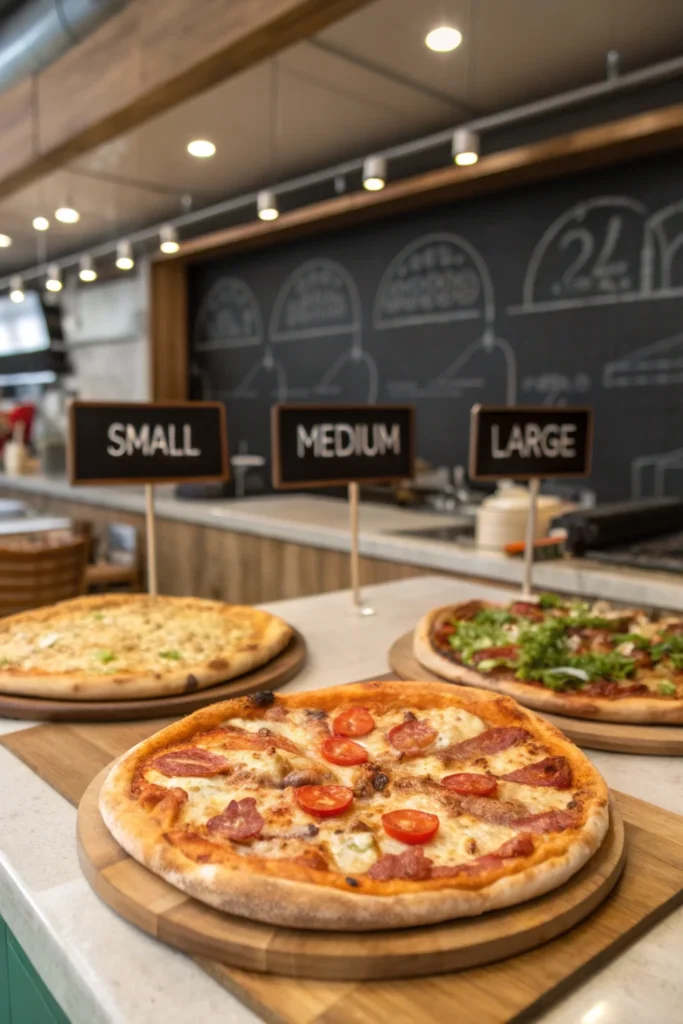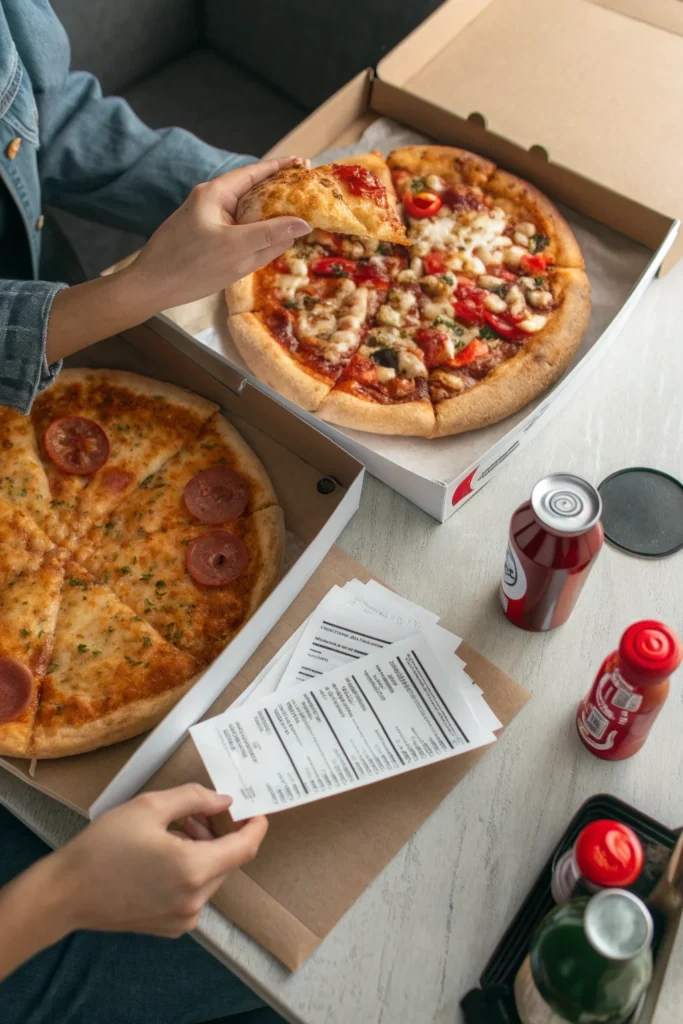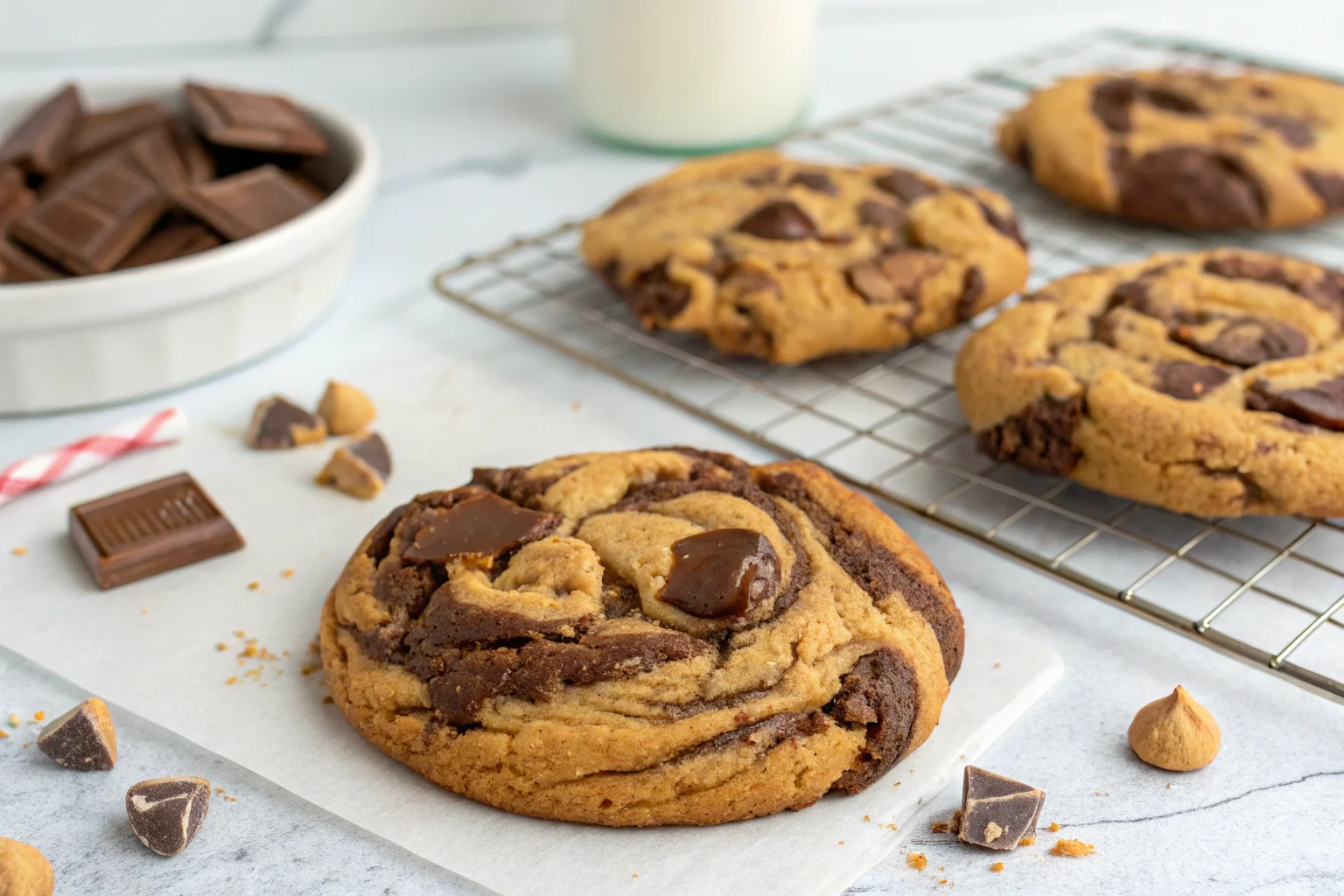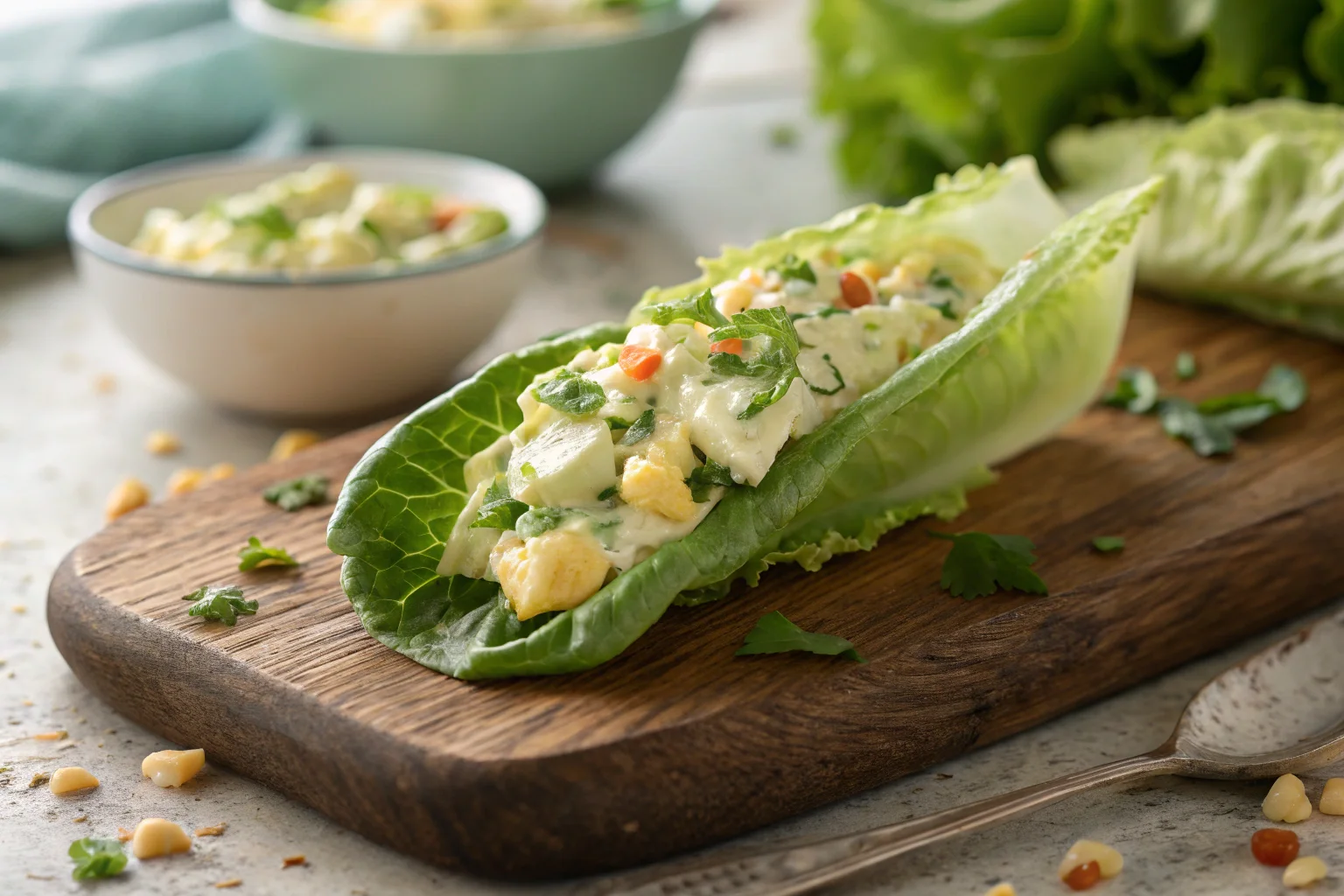Table of Contents
ToggleIntroduction
Pizza is one of the most beloved foods worldwide, but when it comes to ordering, a common question arises: What’s the best pizza size for value? Should you go for one large pizza, or are two mediums the better deal? The answer isn’t always as obvious as it seems.
The truth is, pizza pricing isn’t just about the cost—it’s about how much pizza you’re actually getting for your money. A large pizza may seem pricier upfront, but when you break it down, it often provides more pizza per dollar than smaller sizes. In this article, we’ll explore:
- How pizza sizes and prices compare across popular pizza chains
- The math behind cost per square inch
- Why bigger pizzas often offer the best value
- Tips for ordering the right amount based on your needs
By the end, you’ll know exactly how to maximize your pizza order for both flavor and savings.
Wondering how many people a 10-inch pizza can feed? Find out the exact serving size and portion guide in our detailed breakdown.” → How Many People Can Eat a 10-Inch Pizza?
Understanding Pizza Sizes and Pricing
Pizza Size Variations
Pizza sizes can vary from one restaurant to another, but in general, they fall into these categories:
| Size | Diameter (inches) | Slices |
|---|---|---|
| Small | 8-10” | 6 |
| Medium | 12-14” | 8 |
| Large | 16-18” | 10-12 |
| Extra-Large | 18”+ | 12+ |
The larger the pizza, the more surface area it has, which directly affects the amount of food you’re getting. A small pizza might be great for one or two people, but when feeding a group, going bigger could be the smarter choice.
How Pizza Pricing Works
The price of pizza isn’t just determined by size—it’s influenced by a variety of factors, including:
- Ingredients and toppings – More toppings usually mean a higher price. Specialty pizzas often cost more than basic cheese or pepperoni.
- Crust type – Thick, stuffed, or gourmet crusts add extra costs.
- Brand and location – Prices can vary based on the pizza chain and geographical location.
- Deals and promotions – Many chains offer discounts that can make certain sizes more economical.
Why Some Sizes Seem Overpriced
Ever noticed that a medium pizza sometimes costs almost as much as a large? That’s because pizza chains know that many people order out of habit rather than doing the math. They price smaller pizzas in a way that makes the larger option seem like a better deal—because it usually is!
Pizza Math – Calculating the Best Value
When trying to figure out what’s the best pizza size for value, the cost per square inch is the key to making an informed decision. It turns out, bigger pizzas usually offer the best deal—but why? Let’s break it down.
Why Bigger Pizzas Are Usually Cheaper Per Inch
Pizza isn’t priced by weight or volume—it’s priced largely by diameter. However, a pizza’s area (the actual amount of food) increases exponentially with size. The formula for the area of a pizza is: Area=πr2\text{Area} = \pi r^2Area=πr2
Where r is the pizza’s radius (half its diameter).
Let’s compare the actual edible area of different pizzas:
| Size | Diameter (inches) | Radius (inches) | Total Area (sq. in.) |
|---|---|---|---|
| Small | 10” | 5” | 78.5 |
| Medium | 12” | 6” | 113.1 |
| Large | 16” | 8” | 201.1 |
| Extra-Large | 18” | 9” | 254.5 |
A 16-inch pizza isn’t just slightly larger than a 12-inch—it’s nearly twice as big in total area! Yet, in most cases, a 16-inch pizza doesn’t cost twice as much as a 12-inch, making it the better deal per bite.
Real-World Cost Comparisons
Let’s assume a pizzeria charges:
- $10 for a 10-inch small
- $12 for a 12-inch medium
- $15 for a 16-inch large
- $18 for an 18-inch extra-large
Now, let’s calculate the price per square inch:
| Pizza Size | Price | Total Area (sq. in.) | Price per Square Inch |
|---|---|---|---|
| Small (10”) | $10 | 78.5 | $0.127 |
| Medium (12”) | $12 | 113.1 | $0.106 |
| Large (16”) | $15 | 201.1 | $0.075 |
| Extra-Large (18”) | $18 | 254.5 | $0.071 |
Clearly, the larger the pizza, the cheaper it is per square inch. If you’re feeding a group (or just want leftovers), getting a bigger pizza is almost always the best deal.
Using a Pizza Value Calculator
If you don’t want to do the math yourself, pizza value calculators can help. These tools allow you to input:
- Pizza size (diameter)
- Price
- Number of slices
And they’ll instantly tell you the cost per square inch. Popular websites like Omni Calculator and some pizza chain apps have built-in tools for this.
By using these simple calculations, you can always make the smartest pizza purchase.
Looking for a complete guide on 10-inch pizzas? Learn about their size, number of slices, and best toppings for a perfect meal.” → 10-Inch Pizza Guide
One Large Pizza vs. Two Mediums – Which is Better?

Now that we understand pizza math, let’s settle a popular debate: Is it better to order one large pizza or two medium pizzas?
Breaking Down the Numbers
Many people assume that two medium pizzas will give them more food than one large. But when we actually compare surface area, the reality is surprising.
| Order Option | Total Area (sq. in.) | Price (Estimated) |
|---|---|---|
| One 16” Large Pizza | 201.1 sq. in. | $15 |
| Two 12” Medium Pizzas | 226.2 sq. in. | $24 |
At first glance, two mediums give slightly more pizza, but at a much higher price. You’d be paying $9 more for just 25 more square inches, making it a worse deal per bite.
Why the Large Pizza Wins in Most Cases
- Lower price per square inch – As we saw earlier, large pizzas almost always cost less per square inch than multiple smaller ones.
- More even slices – With one large pizza, you can cut it however you want to fit your group’s needs.
- Better topping coverage – Larger pizzas tend to have more even topping distribution, whereas smaller pizzas often have too much crust per bite.
Exceptions to the Rule
Of course, there are some cases where ordering multiple smaller pizzas makes sense:
- Variety is needed – If everyone wants different toppings, getting two or three smaller pizzas may be the better choice.
- Pizza deals or promotions – Some pizza chains offer BOGO (Buy One, Get One Free) deals that make two mediums cheaper than one large.
- Portion control – If you’re splitting pizza between kids and adults, multiple smaller pizzas can help balance portion sizes.
Final Verdict: Which Should You Choose?
If you want the most pizza for your money, go for the large. But if your group has diverse tastes or you find a great BOGO deal, multiple mediums might be the way to go.
The Psychology Behind Pizza Ordering – Why We Choose Certain Sizes
When deciding what’s the best pizza size for value, numbers alone don’t always determine our choices. Many of us pick a pizza size based on perception, emotions, and marketing tactics rather than actual value. But why? Let’s explore the psychological factors that influence our pizza-buying habits.
How Restaurants Influence Your Pizza Size Choice
Pizzerias use strategic pricing, menu design, and combo deals to subtly steer your decision. Here’s how:
1. Price Anchoring – The “Expensive” Option Trick
Ever noticed that most pizza menus include an extra-large option that seems too pricey? That’s no accident.
- The highest-priced pizza makes the large or medium feel like a bargain in comparison.
- This anchors your expectations, making you more likely to order a size that seems like a better deal, even if it’s not the absolute best value.
2. The Middle Option Bias
Many people naturally gravitate toward the middle option when faced with multiple choices.
- If given small, medium, and large, most will choose medium, thinking it’s the “safe” choice.
- But as we learned in the previous sections, large pizzas often give more value per bite.
3. The “Combo Illusion” – More for Less?
Pizza chains bundle items together to make you feel like you’re getting a better deal.
- A medium pizza with breadsticks and soda seems like more food than a large pizza alone, even if the actual pizza portion is smaller.
- Many times, buying just a bigger pizza is the cheaper and smarter option.
Why We Order More Than We Need
Ever ordered a pizza, thinking you’d only eat a couple of slices—only to finish almost the whole thing? That’s because our brains are wired to overestimate portion sizes.
- Fear of running out – When feeding a group, we over-order to avoid running out of food.
- Leftover logic – We justify buying a larger pizza because we’ll eat the rest later (which isn’t a bad strategy if you actually do!).
- Bigger feels like a celebration – Large pizzas create a party-like atmosphere, making people more likely to choose them for gatherings.
Does Size Affect Perceived Taste?
Interestingly, research suggests that people perceive larger pizzas as tastier. Why?
- Larger slices make us feel like we’re getting more for our money, enhancing satisfaction.
- More toppings per bite – Larger pizzas distribute toppings more evenly, so every bite is loaded with flavor.
How to Get the Best Pizza Value Every Time
Now that we know what’s the best pizza size for value, how can we make smarter ordering choices every time? Here are some expert pizza-saving hacks to maximize your budget.
Best Strategies for Saving Money on Pizza
1. Always Compare Price per Square Inch
Before ordering, do a quick size and price comparison using the formula: Price per sq. inch=Total PriceTotal Area in Sq. Inches\text{Price per sq. inch} = \frac{\text{Total Price}}{\text{Total Area in Sq. Inches}}Price per sq. inch=Total Area in Sq. InchesTotal Price
In most cases, bigger is better when it comes to savings.
2. Look for Deals and Coupons
Pizza chains run promotions constantly, so check for:
- BOGO (Buy One, Get One Free) deals – Great when feeding a group.
- Discounted pickup specials – Ordering directly from the store often saves money.
- Loyalty programs – Many pizzerias offer free pizzas after a certain number of purchases.
3. Skip the Extras (or Make Them at Home)
While combo deals seem like a great bargain, adding drinks, breadsticks, and desserts inflates your bill.
- Make your own garlic bread at home for a fraction of the price.
- Buy a 2-liter soda from the store instead of paying premium restaurant prices.
4. Customize Your Pizza for More Value
Some toppings cost the same, no matter the size. Maximize your money by:
- Ordering a plain large pizza and adding toppings at home.
- Asking for extra sauce or seasoning—most places don’t charge for this.
- Getting a half-and-half pizza instead of ordering two separate ones.
Should You Choose Carryout or Delivery?
Another way to save is to opt for carryout instead of delivery.
- Delivery fees and tips add an extra $5–$10 to your order.
- Many pizza chains offer carryout-exclusive discounts—sometimes up to 50% off.
If you live close to a pizzeria, picking up your pizza can save you a significant amount over time.
How to Make the Most of Leftover Pizza
Even when you’ve figured out what’s the best pizza size for value, you might still have leftovers. But don’t let that extra pizza go to waste! With the right storage and reheating methods, you can keep your pizza tasting fresh and delicious for days.
The Best Ways to Store Leftover Pizza
1. Refrigeration: Keeping It Fresh for a Few Days
If you plan to eat your pizza within three to four days, the fridge is your best bet. Here’s how to keep it from getting soggy or stale:
- Avoid stacking slices directly – Instead, place a piece of parchment or wax paper between each slice.
- Wrap slices in foil or plastic wrap – This helps prevent drying out.
- Use an airtight container – A sealed container locks in moisture while keeping bad odors out.
2. Freezing: Long-Term Storage Solution
Got too much pizza to finish in a few days? Freeze it!
- Wrap individual slices in plastic wrap, then place them in a freezer bag.
- Remove as much air as possible to prevent freezer burn.
- Frozen pizza stays good for up to two months.
How to Reheat Pizza So It Tastes Fresh
Reheating pizza the wrong way can leave it rubbery, dry, or soggy. Here’s the best method for every situation:
1. The Oven Method (Best for Large Quantities)
- Preheat your oven to 375°F (190°C).
- Place the pizza on a baking sheet or directly on the oven rack for crispier crust.
- Bake for 8-10 minutes until the cheese is melted and the crust is crispy.
2. The Skillet Method (Best for One or Two Slices)
Want a crispy bottom and gooey cheese? Use a skillet:
- Heat a non-stick or cast-iron pan over medium heat.
- Place the pizza in the pan without oil and cover with a lid.
- Cook for 2-3 minutes, then add a few drops of water to the pan (not on the pizza!). Cover again for another minute.
3. The Air Fryer Method (Quick and Crispy)
If you have an air fryer, it’s a fast and effective way to reheat pizza:
- Set it to 350°F (175°C).
- Place the slice in the air fryer basket.
- Heat for 3-5 minutes until crispy.
4. The Microwave Method (For When You’re in a Hurry)
Microwaving pizza can turn it rubbery, but there’s a trick:
- Place a cup of water next to your pizza in the microwave.
- Heat in 30-second intervals until warm.
- This keeps the crust from getting too chewy.
By using these storage and reheating methods, you can make your pizza last longer without sacrificing flavor!
Homemade vs. Restaurant Pizza – Which Offers the Best Value?

When asking what’s the best pizza size for value, you might also wonder: Should I make pizza at home or order from a restaurant? Both have pros and cons, but let’s compare cost, quality, and convenience.
Cost Comparison: Is Homemade Pizza Cheaper?
1. Ingredient Costs for Homemade Pizza
Making pizza at home can be more affordable, especially if you’re feeding multiple people. Here’s a breakdown:
| Ingredient | Estimated Cost | How Many Pizzas It Makes |
|---|---|---|
| Pizza Dough (Store-bought) | $2 – $4 | 1-2 large pizzas |
| Cheese | $4 – $6 | 2 pizzas |
| Tomato Sauce | $2 – $3 | 2-3 pizzas |
| Toppings (Pepperoni, Vegetables, etc.) | $5 – $8 | Multiple pizzas |
| Total Cost per Large Pizza | $5 – $8 | (Varies by toppings) |
In contrast, a large pizza from a restaurant can cost $15 – $20 or more, making homemade pizza a budget-friendly alternative.
2. Time and Effort – Is It Worth It?
While homemade pizza is cheaper, it does require:
- Time to prepare the dough (unless you buy pre-made).
- Effort in assembling and baking.
- Clean-up after cooking.
If you’re in a rush, ordering from a pizzeria saves time, but you pay for the convenience.
Taste and Quality – Which Is Better?
1. Fresh Ingredients vs. Processed Ingredients
- Homemade pizza allows you to control ingredient quality—you can use organic tomatoes, fresh mozzarella, and high-quality meats.
- Many chain pizzerias use preservatives and processed cheese to cut costs.
2. Customization and Dietary Preferences
Homemade pizza is perfect for special diets:
- Make it gluten-free or low-carb.
- Adjust cheese and toppings exactly how you like.
- Avoid excessive oil and sodium found in some fast-food pizzas.
Final Verdict: Which Offers the Best Value?
If cost is your main concern, homemade pizza wins. But if you value convenience and consistency, restaurant pizza might be the better choice.
Still, when ordering out, always check pizza size-to-price ratios to ensure you’re getting the best deal for your money!
Tips for Getting the Best Pizza Deals
When ordering pizza, getting the best deal isn’t just about choosing what’s the best pizza size for value—it’s also about using smart shopping strategies. Whether you prefer delivery, takeout, or dining in, these tips will help you save money while enjoying great pizza.
How to Find the Best Pizza Discounts and Promotions
1. Check for Coupons and Online Deals
Most pizzerias offer discount codes and digital coupons. Before placing an order:
- Visit the official website or app of your favorite pizza chain.
- Use third-party coupon sites like RetailMeNot or Honey.
- Check for email or text message promotions from pizza places.
2. Take Advantage of Loyalty Programs
Many pizza chains reward repeat customers with free pizzas, discounts, and exclusive deals. Popular programs include:
- Domino’s Piece of the Pie Rewards – Earn points for every order and get a free pizza.
- Pizza Hut’s Hut Rewards – Collect points for free food.
- Local pizza shops often have punch cards or point systems.
3. Order During Special Promotions
Keep an eye out for:
- BOGO (Buy One, Get One Free) deals on large pizzas.
- Discounted meal bundles that include drinks and sides.
- Happy hour or late-night specials at select restaurants.
Ordering Tricks to Get More Pizza for Your Money
1. Upsize for Better Value
A large pizza is usually a better deal than two smalls. Since the cost of ingredients and labor is spread out, a single large pizza offers:
- More square inches of pizza per dollar.
- Better crust-to-topping ratio for flavor.
- Less waste and packaging.
2. Consider Carryout Instead of Delivery
Delivery fees, tips, and service charges add up. Instead, opt for carryout to:
- Avoid extra fees.
- Take advantage of carryout-only discounts.
- Get your pizza hot and fresh right from the oven.
3. Customize Your Order to Save Money
- Order extra toppings on the side – They’re often cheaper than getting multiple specialty pizzas.
- Ask for half-and-half pizzas – You get variety without buying two pizzas.
- Stick to classic toppings – Premium toppings (shrimp, steak, truffle oil) often cost extra.
By combining these strategies, you’ll maximize savings while still getting delicious, high-quality pizza!
Final Thoughts – Choosing the Best Pizza Size for Value
After exploring all the factors—cost, convenience, quantity, and quality—you’re now equipped to make smarter pizza choices. But let’s wrap up with some final thoughts to help you decide what’s the best pizza size for value every time.
Key Takeaways for Finding the Best Pizza Size
1. Bigger is Usually Better for Value
- Large and extra-large pizzas give you more food per dollar compared to smaller sizes.
- The cost per square inch decreases as pizza size increases.
- If you don’t finish it all, leftovers can be stored and reheated easily.
2. Consider Your Group Size and Appetite
- For one or two people, a medium pizza might be more practical.
- For families or parties, a single large pizza is cheaper than multiple small ones.
- If people prefer different toppings, getting multiple smaller pizzas could be worth it.
3. Always Compare Prices and Deals
- Check online discounts, coupon codes, and loyalty rewards before ordering.
- Consider carryout specials instead of delivery to avoid extra fees.
- Customize your order to get the most toppings and food for your money.
Final Verdict: What’s the Best Pizza Size for Value?
If you’re looking for the best value overall, a large pizza is the winner in most cases. It offers:
✔️ More pizza per dollar spent
✔️ Lower cost per square inch
✔️ Better sharing potential
✔️ Easy leftovers for future meals
However, your personal preferences, budget, and appetite all play a role in choosing the right size. Next time you order, use these tips to get the most delicious deal possible!









